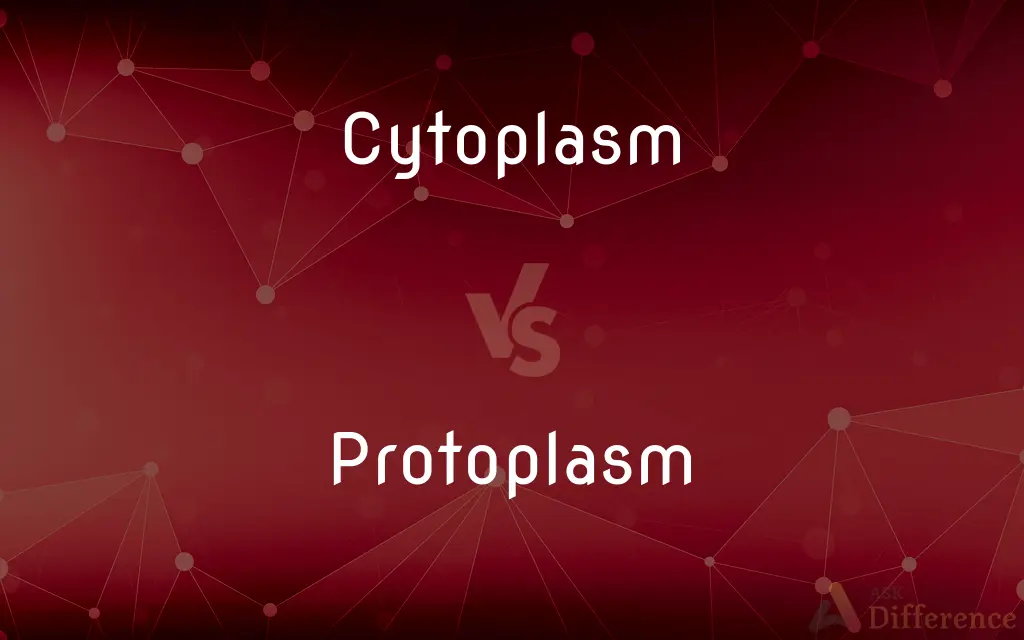Cytoplasm vs. Protoplasm — What's the Difference?
By Tayyaba Rehman & Maham Liaqat — Updated on March 21, 2024
Cytoplasm is the jelly-like substance inside the cell membrane, excluding the nucleus, while protoplasm includes both cytoplasm and the nucleus.

Difference Between Cytoplasm and Protoplasm
Table of Contents
ADVERTISEMENT
Key Differences
Cytoplasm refers to the jelly-like material occupying the space between the cell membrane and the nuclear envelope in eukaryotic cells. It is where most cellular activities occur, filled with organelles. Protoplasm, on the other hand, encompasses the entire content of a cell, including the cytoplasm and the nucleus. It is considered the "living part" of the cell, essential for its functioning.
While cytoplasm is mainly involved in the metabolic processes of the cell due to its content of organelles like mitochondria and ribosomes, protoplasm includes these metabolic activities and the genetic material within the nucleus. This makes protoplasm broader in its functional implications, including both the activities in the cytoplasm and the genetic instructions in the nucleus.
The composition of cytoplasm includes water, salts, and organic molecules, making it a site for many chemical reactions necessary for cell survival. Whereas, protoplasm's composition adds to this by including the nucleoplasm, the substance of the nucleus, which contains DNA and nucleoli, further enriching its functional capacity.
In terms of visibility under a microscope, the cytoplasm can be observed as a clear, structured substance surrounding the nucleus and organelles. Protoplasm, however, refers to the entire cell content, giving a holistic view of the cell’s internal environment when observed.
Cytoplasm plays a crucial role in supporting cell structures and providing a medium for the organelles to remain suspended and carry out their functions. Protoplasm, embodying both cytoplasm and nucleus, highlights the interdependence of cellular components for life processes, illustrating the complexity of life at the cellular level.
ADVERTISEMENT
Comparison Chart
Definition
Jelly-like substance inside the cell membrane, excluding the nucleus.
Includes both cytoplasm and the nucleus, the entire content of a cell.
Components
Organelles (except nucleus), cytosol, inclusions.
Cytoplasm + nuclear content (DNA, nucleolus).
Function
Site for metabolic processes and reactions.
Encompasses all cell functions, including metabolism and genetics.
Visibility
Seen as a structured substance surrounding the nucleus.
Refers to the entire cell content, more comprehensive.
Significance
Supports cell structures, mediates cellular activities.
Represents the living part of the cell, essential for its functioning.
Compare with Definitions
Cytoplasm
The jelly-like substance inside the cell that contains organelles, excluding the nucleus.
The cytoplasm of a muscle cell is rich in mitochondria to meet energy demands.
Protoplasm
Contains all the components necessary for the life of a cell.
Protoplasm includes DNA, which carries genetic information.
Cytoplasm
A component of the cell essential for its structural integrity.
Without cytoplasm, cells would collapse.
Protoplasm
The physical basis of life within a cell.
Protoplasm's activity is essential for cell growth and reproduction.
Cytoplasm
The part of the cell where most metabolic processes occur.
Enzymes in the cytoplasm catalyze the breakdown of glucose.
Protoplasm
Represents the complexity and interdependence of cell components.
Damage to the protoplasm can lead to cell death.
Cytoplasm
The medium that supports organelles in a cell.
Organelles float in the cytoplasm, performing their specific functions.
Protoplasm
The medium where cellular processes, including genetic activities, occur.
The protoplasm facilitates the interaction between cytoplasmic and nuclear functions.
Cytoplasm
The site for cellular activities excluding those in the nucleus.
The cytoplasm is where protein synthesis begins before completion in the endoplasmic reticulum.
Protoplasm
The entire content of a cell, including cytoplasm and nucleus.
Protoplasm is considered the living part of the cell.
Cytoplasm
The substance of the body of a cell, as distinguished from the karyoplasma, or substance of the nucleus.
Protoplasm
Protoplasm (/prəʊtə(ʊ)ˌplaz(ə)m/, plural protoplasms) is the living part of a cell that is surrounded by a plasma membrane. In some definitions, it is a general term for the cytoplasm (e.g., Mohl, 1846), but for others, it also includes the nucleoplasm (e.g., Strasburger, 1882).
Cytoplasm
In cell biology, the cytoplasm is all of the material within a eukaryotic cell, enclosed by the cell membrane, except for the cell nucleus. The material inside the nucleus and contained within the nuclear membrane is termed the nucleoplasm.
Protoplasm
The complex, semifluid, translucent substance that constitutes the interior matter of a living cell and is composed of proteins, fats, and other molecules suspended in water. It includes the cytoplasm, the nucleus in eukaryotes, and organelles such as mitochondria.
Cytoplasm
The protoplasm enclosed by the plasma membrane of cell, excluding the nucleus in eukaryotic cells and cellular DNA in prokaryotic cells.
Protoplasm
(cytology) The entire contents of a cell comprising the nucleus and the cytoplasm. It is a semi-fluid, transparent substance which is the living matter of plant and animal cells.
Cytoplasm
(cytology) The contents of a cell except for the nucleus. It includes cytosol, organelles, vesicles, and the cytoskeleton.
Protoplasm
The viscid and more or less granular material of vegetable and animal cells, possessed of vital properties by which the processes of nutrition, secretion, and growth go forward; the so-called " physical basis of life;" the original cell substance, cytoplasm, cytoblastema, bioplasm sarcode, etc.
Cytoplasm
The protoplasm of a cell excluding the nucleus
Protoplasm
The living substance of a cell (including cytoplasm and nucleus)
Common Curiosities
How does cytoplasm differ from protoplasm?
Cytoplasm excludes the nucleus and focuses on the area where cellular activities occur, while protoplasm includes both the nucleus and cytoplasm, representing all cell contents.
What is cytoplasm?
Cytoplasm is the jelly-like substance within the cell membrane but outside the nucleus, containing organelles and involved in metabolic processes.
Can you see cytoplasm and protoplasm under a microscope?
Yes, both can be observed under a microscope, with cytoplasm appearing as a clear substance around organelles, and protoplasm showing the cell's entire content.
What is protoplasm?
Protoplasm includes both the cytoplasm and the nucleus, encompassing the entire living content of a cell.
Why is protoplasm important?
Protoplasm is vital as it contains all the components necessary for the cell's life, including its genetic material and sites for metabolic activities.
What is the composition of protoplasm?
Besides the components of cytoplasm, it includes the nucleoplasm, which contains the cell’s DNA and nucleolus.
Can protoplasm regenerate?
Protoplasm has the ability to repair and regenerate to some extent, depending on the severity of the damage and the type of cell.
What role does the cytoplasm play in a cell?
It supports cell structures, provides a medium for organelles to carry out functions, and is the site for most metabolic reactions.
How does the cytoplasm affect cellular functions?
It plays a crucial role in cellular metabolism, organelle function, and structural integrity, affecting overall cell health and activity.
Does the cytoplasm contain DNA?
No, DNA is located in the nucleus within eukaryotic cells; however, in prokaryotes, DNA resides in the cell region not encapsulated by a nucleus, often referred to as the nucleoid.
What is the composition of cytoplasm?
It consists of water, salts, organic molecules, and organelles, excluding the nucleus.
How are cytoplasm and protoplasm related?
Protoplasm is a broader term that includes cytoplasm (minus the nucleus) as one of its components, alongside the nucleus and its contents.
Is protoplasm unique to eukaryotic cells?
No, the concept of protoplasm applies to both eukaryotic and prokaryotic cells, as it refers to the entire living content inside the cell membrane.
What happens if the cytoplasm is damaged?
Damage to the cytoplasm can disrupt cellular processes and organelle functions, potentially leading to cell death.
Share Your Discovery

Previous Comparison
Firefly vs. Dragonfly
Next Comparison
Defile vs. DefineAuthor Spotlight
Written by
Tayyaba RehmanTayyaba Rehman is a distinguished writer, currently serving as a primary contributor to askdifference.com. As a researcher in semantics and etymology, Tayyaba's passion for the complexity of languages and their distinctions has found a perfect home on the platform. Tayyaba delves into the intricacies of language, distinguishing between commonly confused words and phrases, thereby providing clarity for readers worldwide.
Co-written by
Maham Liaqat













































